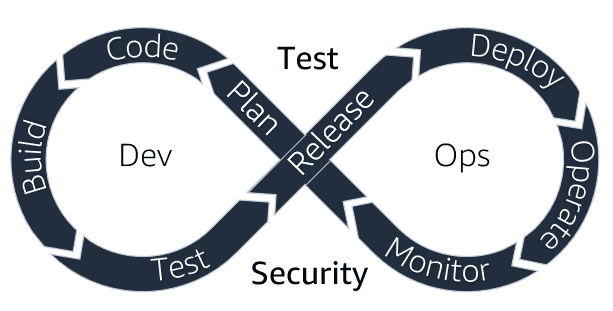DevOps is a set of cultural philosophies, practices, and tools that improve an organization’s ability to deliver software and services at high speeds. It develops and improves products at a faster rate than organizations using traditional software development and infrastructure management processes. So, faster speed allows companies to better serve their customers and compete in the marketplace. DevOps focuses on improving collaboration and efficiency so teams can grow faster and deliver more value to organizations and customers.

DevOps is short for Development (Dev) and Operations (Ops). Devs are the people and processes that create software. Ops are the teams and processes that deliver and monitor the software. DevOps introduces a set of principles and practices to achieve faster delivery, higher quality, and more reliable software.
Developers change things quickly, release often, and measure success by the rate of delivery. Operations are driven by maintaining the stability of the application. Frequent releases are a cause for concern for the stability and reliability of the application on the supported platforms, especially during high network traffic.
DevOps brings together formerly siloed roles (development, IT operations, quality engineering, and security) to optimize the productivity of developers and the reliability of operations.
Benefits of DevOps
DevOps brings several benefits to organizations that adopt its practices.
- Faster and better product delivery.
- Faster problem resolution and less complexity.
- Greater scalability and availability.
- More stable operating environment.
- Better use of resources.
- Greater automation.
- To increase the transparency of the results of the system.
- Big innovation.
Methods of DevOps
DevOps practices encompass a range of principles, methodologies, and tools that facilitate collaboration, automation, and continuous improvement between development and operations teams. Here are some key DevOps practices:
- Continuous Integration (CI): Developers frequently integrate their code changes into a shared repository, enabling early detection of integration issues. Automated build and test processes are employed to ensure the stability and quality of the codebase.
- Continuous Delivery (CD): The goal of continuous delivery is to automate the software release process and make it possible to release software changes to production environments frequently and reliably. CD pipelines automate the building, testing, and deployment of applications, reducing manual effort and enabling faster time-to-market.
- Infrastructure as Code (IaC): Infrastructure provisioning, configuration, and management are treated as code artifacts. IaC allows for the automation and version control of infrastructure, ensuring consistency and reproducibility. However, tools like Terraform and CloudFormation are commonly used for IaC.
- Continuous Deployment (CD): This practice, like continuous delivery, automatically delivers new or updated code to production. Continuous deployment companies may release code or feature changes multiple times per day. Container technologies, such as Docker and Kubernetes, can help maintain code consistency across different deployment platforms and environments, allowing for continuous deployment.
- Configuration Management: Configuration management tools, such as Ansible, Puppet, or Chef, automate the provisioning, configuration, and management of software and infrastructure components. They help maintain consistency across environments and simplify the management of complex systems.
- Continuous Testing: Continuous testing involves automated testing throughout the software development lifecycle. Plus, It includes unit testing, integration testing, performance testing, security testing, and other types of tests. Automated testing ensures the quality of software changes and reduces the risk of introducing bugs or regressions.
- Monitoring and Logging: Monitoring tools are used to gain insights into system performance, detect issues, and gather feedback on application behavior. Also, Logging helps capture important events and data for analysis and troubleshooting. Continuous monitoring and logging enable teams to proactively identify and address issues, ensuring system stability and performance.
DevOps is a combination of
- Cultural philosophies for removing barriers and sharing end-to-end responsibility
- Processes developed for speed and quality, that streamline the way people work
- Tools that align with processes and automate repeatable tasks, making the release process more efficient and the application more reliable

As you go through the course, keep in mind that teams practice DevOps to increase innovation and agility, improve quality, release faster, and lower cost. Hence, DevOps improves delivery efficiency and predictability of the application and services.
Read More: What Is The Difference Between An Algorithm And A Program?
Conclusion
In conclusion, DevOps is a set of practices and cultural values that aim to bridge the gap between software development and operations teams. So, it promotes collaboration, communication, and integration between these traditionally siloed teams to enable faster, more reliable, and more efficient software delivery.